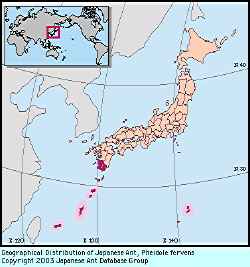
|
species
|
Pheidole fervens
|
 |
Japanese Name
|
Minami-oozu-ari
|
Original Reference
|
|
Smith, F. (1858) Catalogue of Hymenopterous Insects in the Collection of the British Museum 6 Formicidae: 216 pp. London.
|
Description
|
|
Total length of body around 4.5 mm in soldiers, around 3 mm in workers. Body color light reddish brown, head darker, mesosoma lighter, gaster blackish brown. In soldiers: head covered with reticulate sculpturing; eyes rather small, their maximum diameter (ca 0.18 mm) less than length of 10th antennal segment; gular dentition with paired lateral processes, the three median projections indistinct; pronotum and mesonotum separately raised; propodeal spines slender, curved posteriorly; postpetiole shorter than petiole. In workers: posterior portion of head rounded, smooth and shining, with distinct occipital carina; eyes small, like those of soldiers (0.26 - 0.30 mm in diameter); gular dentition undeveloped; remaining features as given for soldier.
|
Remarks
|
|
This species occurs in southern Kyushu and the Ryukyus. It is found nesting under stones in open land grading to forest margins (Ogata, 1981). Colonies can include hundreds of workers (Yano, pers. comm.). Habitat preference, body size and coloration are similar to Pheidole indica, P. noda and P. megacephala. In fact, these species are sometimes closely sympatric in the Ryukyus. P. fervens can be distinguished by its lighter body color, smaller eyes, the relatively fine reticulation on the heads of its soldiers, the shape of the propodeal spines and the proportions of its postpetiole.
|
|

Distribution
|
|
Kyushu (southern part), Nansei Is; Mainland China, Taiwan, SE Asia, Sri Lanka, Oceania.
|
|
Editor
|
|
Original text by Kazuo Ogata and Seiki Yamane. English translation by Kazuo Ogata, edited by Robert W. Taylor.
|
|